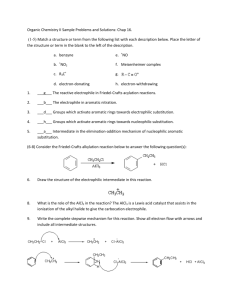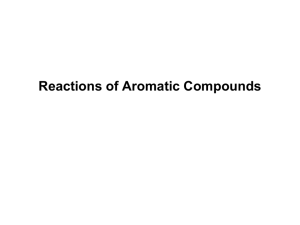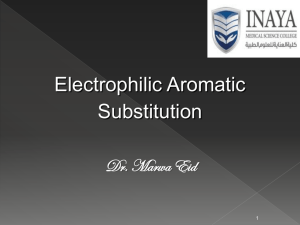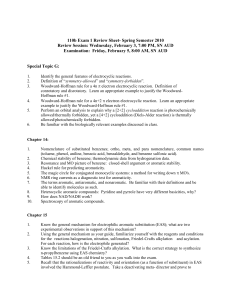Chapter 15 Electrophilic Aromatic Substitution on Arenes
advertisement
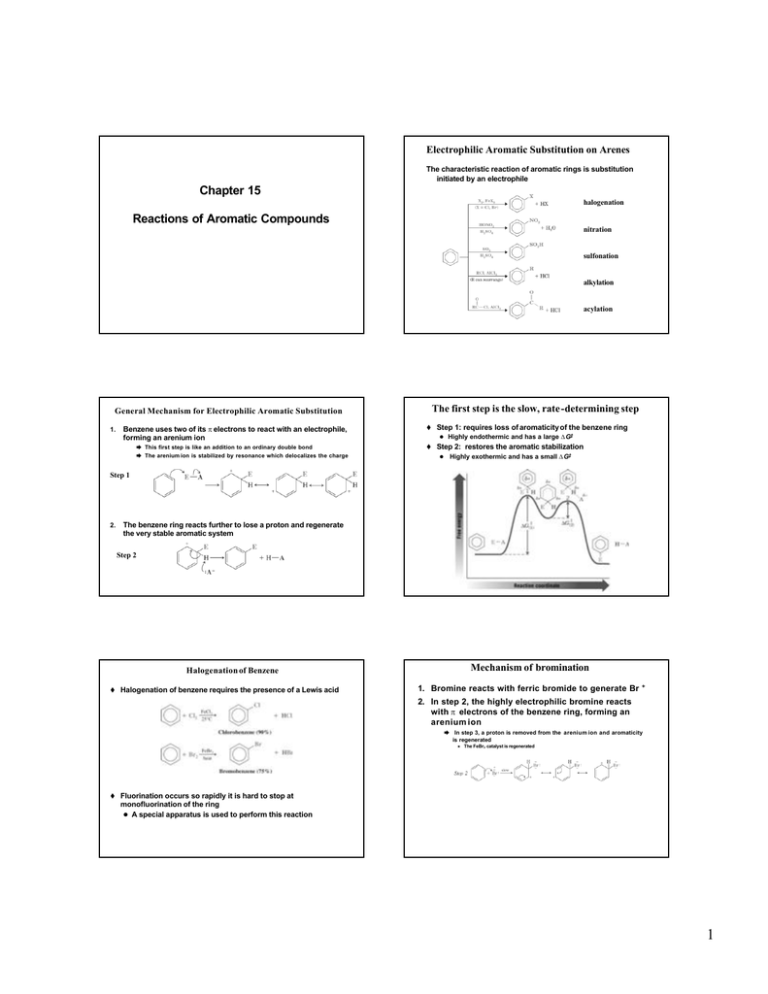
Electrophilic Aromatic Substitution on Arenes The characteristic reaction of aromatic rings is substitution initiated by an electrophile Chapter 15 halogenation Reactions of Aromatic Compounds nitration sulfonation alkylation acylation General Mechanism for Electrophilic Aromatic Substitution 1. Benzene uses two of its π electrons to react with an electrophile, forming an arenium ion è This first step is like an addition to an ordinary double bond è The arenium ion is stabilized by resonance which delocalizes the charge The first step is the slow, rate-determining step t Step 1: requires loss of aromaticity of the benzene ring l Highly endothermic and has a large ∆ G‡ t Step 2: restores the aromatic stabilization l Highly exothermic and has a small ∆ G‡ Step 1 2. The benzene ring reacts further to lose a proton and regenerate the very stable aromatic system Step 2 Mechanism of bromination Halogenation of Benzene t Halogenation of benzene requires the presence of a Lewis acid 1. Bromine reacts with ferric bromide to generate Br + 2. In step 2, the highly electrophilic bromine reacts with π electrons of the benzene ring, forming an arenium ion è In step 3, a proton is removed from the arenium ion and aromaticity is regenerated H The FeBr3 catalyst is regenerated t Fluorination occurs so rapidly it is hard to stop at monofluorination of the ring l A special apparatus is used to perform this reaction 1 Mechanism of bromination Why bromine substitutes, and doesn’t add As in most EAS, there is a preliminary reaction or equilibrium to generate a strong electrophile Bromine reacts with ferric bromide to generate Br + H H Br2 H Br H H o ∆H = -29 kcal Br H Br2 Br H H o ∆H = +2 kcal Br the FeBr3 catalyst is regenerated Nitration of Benzene Iodination requires an oxidizing acid Nitration requires a mixture of concentrated nitric and sulfuric acids Sulfuric acid is stronger and protonates nitric acid 2H+ + 2HNO3 + I 2 → 2I + + 2NO2 + 2H2 O Generates I+ I 2 I2 + 2 HNO3 + 2NO2 + 2H2O 2 l Protonated nitric acid dissociates to produce the actual electrophile, the nitronium ion (NO2 +) Nitration of Benzene Sulfonation of Benzene Nitronium ion initiates the attack on benzene t Sulfonation occurs most rapidly using fuming sulfuric acid (concentrated sulfuric acid that contains SO3) l The reaction also occurs in conc. sulfuric acid, which can generate small quantities of SO3 Nitronium ion initiates the electrophilic substitution Water (released in step 2, acts as a Lewis base to remove H+ etc. Overall reaction + HNO 3 H 2SO 4 NO 2 + H2O 2 Overall sulfonation reaction and its reverse Sulfonation of Benzene t Two proton transfers complete the process Sulfonation is reversible; each step is an equilibrium t The sulfonation product is favored by use of concentrated or fuming sulfuric acid t Desulfonation can be accomplished 1. using dilute sulfuric acid ( i.e. a high concentration of water) Overall reaction + S O3 SO3H H2 SO4 2. or by passing steam through the reaction and collecting the volatile desulfonated compound as it codistils with steam Friedel-Crafts Alkylation t Mechanism of Friedel-Crafts Alkylation An aromatic ring can be alkylated by an alkyl halide in the presence of a Lewis acid l Example: synthesis of isopropylbenzene The Lewis acid serves to generate a carbocation electrophile Step 1: activation of the alkyl halide by AlCl3 to produce a carbocation Al Cl3 + CH3CH 2Br H 3C CH 3 H3 C C Cl AlCl3 CH 3 C CH 3 + HCl CH 3 Mechanism of Friedel-Crafts Alkylation Other carbocations can be used for Friedel-Crafts alkylation Carbocation acts as the electrophile, seeking the electron rich benzene ring etc. By protonation of alkenes Then proton removed from the arenium ion to form product, also regenerating the catalyst From alcohols 3 Friedel-Crafts Acylation t Acid chlorides are readily made from carboxylic acids An acyl group has a carbonyl attached to some R group acetyl group benzoyl group t Friedel-Crafts acylation requires reaction of an acid chloride or acid anhydride with a Lewis acid such as aluminium chloride Limitations of Friedel-Crafts Reactions The electrophile in Friedel-Crafts acylation is an acylium ion 1. In FC alkylation, carbocation rearrangements often occur An acyliumion is stabilized by resonance etc. Observing any product from the primary halide means some of the intermediate complex reacts directly Followed by loss of proton as in other EAS Limitations of Friedel-Crafts Reactions 2. 3. Aryl and vinyl halides cannot be used in Friedel-Crafts reactions because they do not form carbocations readily 4. Polyalkylation can occur with F.-C. alkylation because the first alkyl group activates the ring toward further substitution Powerful electron-withdrawing groups make an aromatic ring non-reactive toward Friedel-Crafts alkylation or acylation l Amino groups also make the ring less reactive to Friedel -Crafts reaction because they become electron-withdrawing groups upon Lewis acid-base reaction with the Lewis acid catalyst 4 Synthetic Advantages of Friedel-Crafts Acylations t Primary alkyl halides usually gives mixtures of Clemmensen Reduction converts acyl benzenes to alkyl benzenes Zinc amalgam and hydrochloric acid reduces phenyl ketones to the methylene (CH 2) group rearranged products in Friedel -Crafts alkylation t Acylium ions do not rearrange t Alkyl benzenes often react further because they are FC acylation plus Clemmenson reduction gives straight chain alkyl benzenes activated t Acyl benzenes are deactivated and do not react further t Unbranched alkylbenzenes can be obtained in good yield by acylation followed by reduction t This method can be used to add a ring to an aromatic ring Effects of Ring Substituents starting with a cyclic anhydride l Note that Clemmensen reagents do not reduce the carboxylic acid t Any group already on an aromatic ring affect both the reactivity and orientation of future substitution 1. Activating groups cause the aromatic ring to be more reactive than benzene 2. Deactivating groups cause the aromatic ring to be less reactive than benzene 3. Ortho-para directors direct future substitution to the ortho and para positions 4. Meta directors direct future substitution to the meta position Activating Groups: Ortho-Para Directors The methyl group of toluene is an ortho-para director t All activating groups are also ortho -para directors l The halides are also ortho-para directors but are mildly deactivating t The methyl group of toluene is an ortho-para director l Toluene reacts more readily than benzene o,p substitition products are found together 5 Amino and hydroxyl groups are also activating and ortho-para directors l These groups are so activating that catalysts are often not necessary t Alkyl groups and heteroatoms with one or more unshared electron pairs directly bonded to the aromatic ring will be ortho-para directors (see chart on slide 22) Halogens are the exception Deactivating Groups: Meta Directors t Strong electron-withdrawing groups such as nitro, carbonyl, carboxyl, nitrile, and sulfonate are deactivators and meta directors Less reactive than benzene Classification of Substitutents: a summary Halo Substitutents are weakly deactivating but are also ortho, para directors l In electrophilic substitution of chlorobenzene, the ortho and para products are major: Why??? - The Effect of Substituents on Reactivity Energy profile of the slow step in electrophilic substitution t Electron-releasing groups activate the ring toward electrophiles l Electron-releasing groups stabilize the transition state of the first step of substitution and lead to lower ∆ G‡ and faster rates t Electron-withdrawing groups deactivate the ring l Electron-withdrawing groups destabilize the transition state and lead to higher ∆ G‡ and slower rates of reaction With deactivating group With activating group 6 Theory of Orientation: Inductive and Resonance Effects t The inductive effect of substituent Q arises from the interaction of the polarized bond to Q with the developing positive charge in the ring as an electrophile reacts with it l If Q is an electron-withdrawing group then attack on the ring is slowed because this leads to additional positive charge on the ring Theory of Orientation: Inductive and Resonance Effects t The resonance effect of Q refers to its ability to increase or decrease the resonance stabilization of the arenium ion l When Q has a lone pair on the atom directly attached to the ring it can stabilize the arenium by contributing a fourth resonance form l A major contributor because of complete octet on all atoms l Other groups that have an electron- withdrawing effect because the atom directly attached to the ring has a partial or full positiv e charge l Resonance donating groups Resonance with an amino group Meta-directing Groups - have either a partial or full positive charge on the atom directly attached to the aromatic ring è A trifluoromethyl group destabilizes the ortho and para substitution pathways by having one poor resonance contributor in the arenium ion è The meta intermediate is not as destabilized and is therefore fa vored Major resonance contributor not possible with meta Ortho -Para Direction and Reactivity of Alkylbenzenes Halo groups are ortho -para directors but also deactivating t Alkyl groups activate aromatic rings by inductively stabilizing the transition state leading to the arenium ion t The electron -withdrawing inductive effect of the halide deactivates haloaromatic compounds toward electrophiles t Alkyl groups are ortho-para directors because they inductively stabilize one of the resonance forms of the arenium ion in ortho, para substitution t The electron -donating resonance effect of the halogen’ s unshared electron pairs is the primary ortho -para directing influence 7 Reactions of the Side Chain of Alkylbenzenes t Benzylic Radicals and Cations l When toluene undergoes hydrogen abstraction from its methyl group it produces a benzyl radical è A benzylic radical is a radical in which the carbon bearing the unpaired electron is directly bonded to an aromatic ring Reactions of the Side Chain of Alkylbenzenes t Benzylic Radicals and Cations l When toluene undergoes hydrogen abstraction from its methyl group it produces a benzyl radical l A benzylic radical is a radical in which the carbon bearing the unpaired electron is directly bonded to an aromatic ring H2 C è Departure of a leaving group by an SN1 process from a benzylic position leads to formation of a benzylic cation H C . l Departure of a leaving group by an SN 1 process from a benzylic position leads to formation of a benzylic cation benzylic cation Benzylic radicals and cations are stabilized by resonance Halogenation of the Side Chain: Benzylic Radicals t Benzylic halogenation takes place under conditions which favor radical reactions t Reaction of N-bromosuccinamide with toluene in the Unpaid electron is delocalized into ring presence of light leads to allylic bromination l Recall N-bromosuccinamide produces a low concentration of bromine which favors radical reaction Positive charge is delocalized into ring Halogenation of the Side Chain: Benzylic Radicals Mechanism is the standard free radical chain reaction t Benzylic halogenation takes place under conditions which favor radical reactions t Reaction of toluene with excess chlorine can produce multiple benzylic chlorinations Note that ring substitution does not compete When ethylbenzene or propylbenzene react under radical conditions, halogenation occurs primarily at the benzylic position 8 Alkenylbenzenes Oxidation of the Side Chain t Conjugated alkenyl benzenes are more stable t Dehydration of the alcohol below yields only the more stable conjugated alkenyl benzene t Alkyl and unsaturated side chains of aromatic rings can be oxidized to the carboxylic acid using hot KMnO4 t Additions to the Double Bond of Alkenylbenzenes l Additions proceed through the most stable benzylic radical or benzylic cation intermediates Synthetic Applications Synthetic applications t When designing a synthesis of substituted benzenes, the order in which the substituents are introduced is crucial Br t Example: Synthesize ortho-, meta-, and para-nitrobenzoic acid from toluene NBS Br 2 FeBr 3 + Br Br o,p always go together, but we also assume we can separate them when needed Use of Protecting and Blocking Groups t Strong activating groups such as amino and hydroxyl t Example: The synthesis of p- and o-nitroaniline from aniline l A sulfonic acid group is used as a blocking group to force ortho substitution cause the aromatic ring to be so reactive that unwanted reactions can take place l These groups activate aromatic rings to oxidation by nitric acid when nitration is attempted; the ring is destroyed l An amino group can be protected (and turned into a moderately activating group) by acetylation 9 Substitution on Disubstituted Benzenes t When two substituents are present on the ring initially, the more powerful activating group determines the orientation of subsequent substitution t Ortho-para directors determine orientation over meta directors t Substitution does not occur between meta substituents due to steric hindrance t Both primary and secondary allylic and benzylic halides can undergo SN 1 or SN 2 reaction l These primary halides are able to undergo SN 1 reaction because of the added stability of the allylic and benzylic carbocation t Allylic and Benzylic Halides in Nucleophilic Substitution Reactions t Allylic and benzylic halides are classified in similar fashion to other halides Reduction of aromatic compounds t Since the benzene ring is very stable, reduction of other functional groups can be carried out t Tertiary allylic and benzylic halides can only undergo SN 1 reaction H2 Pt O Zn(Hg) HC l H OH Forceful reductions of benzene Under vigorous conditions, benzene compounds can be hydrogenated to cyclohexanes (intermediate products not isolable H2, Ni temp, press ure Birch reduction: with dissolving metal conditions, the interesting product is the non-conjugated diene Na, NH3 EtOH 10



